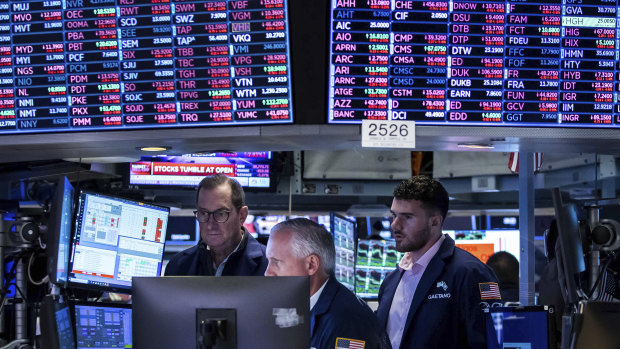Wall St plummets to 22-month low as Fed hawks circle, ASX to drop
By Isabelle Lee and Vildana Hajric
Australian shares are set to slide this morning after Wall Street plunged to the lowest since November 2020 as more Federal Reserve officials struck a hawkish tone, and turmoil in Europe continued to fray investor nerves. The ASX futures is down 0.34%, or 22 points, to 6525 around 7.30am.
The S&P 500 fell as much as 2.9% during Thursday’s session but trimmed losses as markets closed. Its decline wipes out an ill-timed attempt on Wednesday to rebound from a six-day slide.
The tech-heavy Nasdaq 100 dropped nearly 4% during the session after St Louis Fed president James Bullard said investors have now understood that they can’t escape more rate rises in coming months. The index was dragged down by Apple, which fell as much as 6.1% after a rare analyst downgrade from Bank of America warning of weaker consumer demand for its popular devices.
Signs of stress emerged in the interest-rate swaps market and a leveraged-buyout deal was shelved. US Treasuries pared earlier losses, with the 10-year yield hovering around 3.76%.

In Europe, UK gilt yields rose after Prime Minister Liz Truss’s defence of unfunded tax cuts that sent markets into turmoil failed to persuade investors. German inflation topped 10% and the country agreed to energy caps that could add to inflationary pressures.
Investors are grappling with threats posed by discordant moves from central banks over the past few days, with Fed officials adamant on further monetary tightening, the Bank of England unveiling a plan to support government debt and authorities in Asia trying to prop up weakening currencies.
“I was actually really surprised by the impact that the Bank of England had on the global market,” said Fiona Cincotta, senior financial markets analyst at City Index. “Yet, it was short-lived, the relief rally. We sort of pushed past that quite quickly and it seems to be back to that narrative of inflation fears, higher-interest-rate fears.”
Fed officials haven’t shied away from warning that more rate-rise pain is yet to come, with Cleveland Fed president Loretta Mester echoing the rhetoric that her colleagues reinforced this week. San Francisco Fed president Mary Daly, after US markets closed, said the central bank should curb inflation in a manner that avoids a difficult downturn.
Better-than-expected second quarter core PCE and personal consumption numbers on Thursday also paved the path for the Fed to stay aggressive. Weekly jobless claims fell to the lowest since April, showing a persistently tight labour market.
Recession concerns persisted as a gap in the government’s two primary measures of US economic activity during the first half of 2022 narrowed. The National Bureau of Economic Research’s Business Cycle Dating Committee uses this metric and other variables to make any recession call.
“The market is now coming to terms with the idea that a recession is almost a given at this point and it’s really making adjustments for that,” said Shawn Snyder, head of investment strategy at Citi US Wealth Management.
Separately, the European Commission announced an eighth package of sanctions that would include a price cap on Russia’s oil exports as Russia vowed to go ahead with the annexation of the parts of Ukraine that its troops currently control after UN-condemned votes, putting the Kremlin on a fresh collision course with the US and its allies.
Key events this week:
Fed’s Mary Daly speak at an event, Thursday China PMI, Friday Euro zone CPI, unemployment, Friday US consumer income , University of Michigan consumer sentiment, Friday Fed’s Lael Brainard and John Williams speak, Friday
Most Viewed in Business
Source: Thanks smh.com